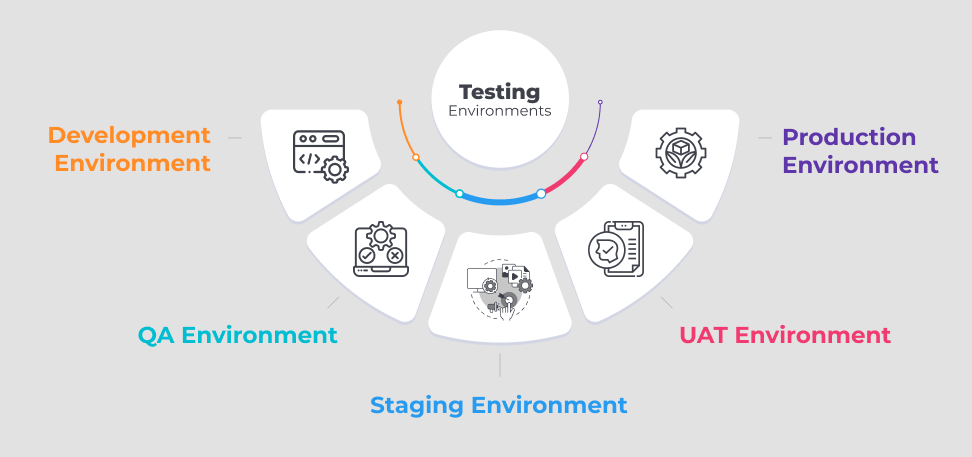
What is Test Environment Management (Image by Test Sigma)

What is Test Environment Management (Image by Test Sigma)
Test environment management is a central aspect of software development, critical to validating software quality.
Test Environment Management (TEM) is a significant piece of the larger puzzle of IT environment management, which aims to reduce risk, improve performance and ensure stability.
Additionally, IT environment management best practices directly benefit TEM by providing a stable and reliable foundation.
Essentially, test environment management involves creating and maintaining a controlled environment in which software can be tested.
This environment replicates production conditions and helps verify that the software works effectively in real-world scenarios.
The value of testing lies in the ability to identify and resolve potential problems before deployment, preventing system failures and ensuring a smooth user experience.
Efficient management of test environments results in more reliable, robust, and high-performing software.
By isolating changes and testing in a dedicated space, developers can make improvements with confidence, reducing the risk of unexpected bugs.
This disciplined approach not only improves software quality, but also contributes to the overall success of the software development lifecycle.
The test environment management process is a systematic approach inherent in software development.
This process is responsible for validating software under conditions that closely mimic real-world production environments.
Effective test environment management is critical to delivering high-quality software, reducing the risk of defects after deployment, and ensuring a seamless user experience.
The process begins with an environment setup, where a testing stage is crafted. This involves selecting the right hardware and software configurations, mirroring real-world scenarios as closely as possible.
It’s not just about replicating the production environment; it’s about understanding the specific requirements of the software being tested and ensuring the environment supports these needs.
The next critical phase is the configuration phase. This is where the software and hardware settings are fine-tuned to match the production environment.
This step is essential to avoid discrepancies between test results and actual performance.
You’ve got to make sure all the pieces are there for the software to work the way you want.
Maintenance as an ongoing process is the next step. Maintenance involves regular updates and patches to the test environment to ensure that it remains aligned with the production environment.
In this maintenance phase, vigilance is key. Even small changes in the environment can result in significant differences in software behavior.
Finally, monitoring is essential to track the performance and usage of the test environment.
This monitoring phase provides insight into potential problems and areas for improvement.
Developers can anticipate how the software will perform in the real world by closely observing how the environment behaves during testing.
Together, these phases form a comprehensive test environment management process that is critical to delivering high-quality, reliable software.
Please note, every life process has challenges. Your love story process has challenges, your test environment management process has challenges.
Several challenges in managing test environments often impact software quality if not addressed properly.
A primary issue is resource allocation. Test environments require hardware and software resources that must mirror production environments.
Limited resources can lead to environments that inadequately simulate real-world scenarios, compromising the testing process’s effectiveness.
Configuration management is another significant hurdle. Ensuring that the test environment accurately reflects the production settings is crucial.
However, maintaining this consistency is challenging, especially when dealing with complex systems or frequent updates.
Any discrepancy between the test and production environments can lead to undetected issues, resulting in software that functions well in testing but fails in actual use.
Another common challenge is environmental stability. Test environments are often unstable due to continuous changes and updates.
This instability can cause unexpected errors during testing, leading to delays and increased costs.
Moreover, poor management of these environments can result in conflicts over resource usage and scheduling, affecting multiple teams.
Inadequate test environment management can seriously impact software quality. If the environment does not accurately represent the production setting, critical bugs may go unnoticed.
This oversight can lead to software failures in real-world applications, resulting in user dissatisfaction, financial loss, and reputational damage.
Effective test environment management is, therefore, vital for ensuring the delivery of robust, reliable, and high-quality software.
A well-managed test environment is a fundamental piece of software development and provides many benefits.
These benefits are supported and obtained through various IT environment management roles and responsibilities within the company.
First, a well-managed test environment streamlines the testing process. Having a stable, reliable, and representative environment to test in means that teams can test more efficiently. This efficiency is a matter of speed, accuracy, and completeness.
With a good test environment, you’re less likely to have false positives or negatives in your test results.
This accuracy leads to faster releases. When you know that your test environment is an exact replica of your production environment, you can move through the test phases more quickly.
There’s less back-and-forth, fewer surprises, and a smoother transition from development to release.
This process also significantly reduces defects. An environment that closely mirrors the real-world conditions in which the software will be used allows testers to identify and address issues more effectively.
This thorough review means fewer bugs make it into the final product, improving software quality.
Finally, a well-managed test environment improves overall test efficiency. Your teams can focus more on actual testing by reducing the time and resources spent identifying and resolving environmental issues.
This focus not only accelerates the development cycle, but also helps produce more reliable and user-friendly software.
Test environment management often goes unnoticed until problems arise, such as when software behaves unexpectedly in production despite passing all tests.
This mismatch can lead to significant problems: customer dissatisfaction, financial loss, and damage to the company’s reputation.
Effective test environment management ensures that software is tested in an environment that closely mimics the actual production environment.
This alignment helps identify and resolve potential problems before the software goes live, significantly reducing the risk of real-world failures.
In doing so, you not only ensure product quality, but also help keep customers trusting and satisfied.
So yes, effectively managing the test environment is a strategic business move to increase the reliability of the software and the credibility of your business.

Test environment management and test automation, though distinct, are intertwined in ensuring software quality.
Test environment management is about setting up and maintaining an environment that mirrors production settings, enabling realistic testing scenarios.
It’s the foundation, ensuring that when you test, you’re doing so in a context that closely resembles where the software will eventually run.
Meanwhile, test automation is about efficiency and consistency in executing those tests.
Test automation leverages tools and scripts to automate repetitive testing tasks, providing speed and precision.
So, the correlation is clear: a well-managed test environment enhances the effectiveness of automated tests.
Without a reliable test environment, automation can falter, leading to inaccurate results.
Together, they form a robust framework for software testing, combining the reliability of a realistic testing ground with the efficiency of automated processes.
The implementation of Test Environment Management (TEM) in an organization requires a methodical approach.
Start by assessing your current testing processes and infrastructure. Please note, this step is critical for accurate testing results.
Identify the types of environments needed (like development, QA, and staging) and ensure they mirror the production environment as closely as possible.
Next, develop a process for environment setup and configuration. This involves defining how environments are created, including the software, hardware, and network configurations.
Consistency is key here; the closer your test environment is to the production, the more reliable your testing will be.
You also need to establish protocols for maintaining and updating these environments.
Regular updates and maintenance are crucial to keep them in sync with the production environment.
This step reduces the risk of discrepancies between test and production performance.
Finally, implement a system for monitoring and managing these environments. This includes tracking their usage, scheduling tests, and ensuring they are available and in the right state when needed.
Effective management of test environments not only enhances the quality of software testing but also optimizes resources and improves overall efficiency.
Remember, clear communication and documentation are essential throughout this process to ensure everyone is on the same page.
Test environment management is important for both business and IT to verify software testing takes place in a controlled, stable environment.
This process helps to identify and address challenges such as the allocation, configuration, and management of resources.
A well-managed test environment leads to significant benefits, including improved software quality, efficient resource utilization, and reduced time-to-market.
So, strengthening test environment management is imperative in today’s rapidly changing technology landscape.
Investing in robust TEM practices is crucial for organizations to meet evolving challenges, leading to better quality products, more efficient processes, and a competitive edge in the market.
Remember, test environment management is so much a strategic approach intertwined with the core objectives of your business and IT operations, it’s not just a task.
Adopt it, strengthen it, and watch test environment management transform your software development lifecycle.